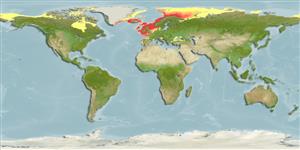Common names from other countries
Classification / Names / Names
Noms communs | Synonymes | Catalog of Fishes (gen., sp.) | ITIS | CoL | WoRMS
Environment: milieu / climate zone / depth range / distribution range
Écologie
; profondeur 15 - 535 m (Ref. 119523). Temperate; 82°N - 41°N, 37°W - 158°E
Distribution
Pays | Zones FAO | Écosystèmes | Occurrences | Introductions
Arctic, Northeast Atlantic and the Mediterranean: Ireland and Germany. Temperate to polar.
Length at first maturity / Taille / Poids / Âge
Maturity: Lm ? range ? - ? cm
Known from infralittoral zones (Ref. 85338). Generally inhabits muddy substrates associated with organic pollutants but also present in sandbanks. A microvore that feeds on organic detritus as well as a carnivore-scavenger (Ref. 96352).
Life cycle and mating behavior
Maturité | Reproduction | Frai | Œufs | Fécondité | Larves
Members of the class Anthozoa are either gonochoric or hermaphroditic. Mature gametes are shed into the coelenteron and spawned through the mouth. Life cycle: The zygote develops into a planktonic planula larva. Metamorphosis begins with early morphogenesis of tentacles, septa and pharynx before larval settlement on the aboral end.
Harms, J. 1993. (Ref. 2711)
Statut dans la liste rouge de l'IUCN (Ref. 130435)
statut CITES (Ref. 108899)
Not Evaluated
Not Evaluated
Utilisations par l'homme
| FishSource |
Outils
Plus d'informations
Taille/Âge
Croissance
Longueur-poids
Longueur-longueur
Morphologie
Larves
Abondance
Sources Internet
Estimates based on models
Preferred temperature
(Ref.
115969): 6.6 - 11.8, mean 8.9 (based on 434 cells).
Catégorie de prix
Unknown.
